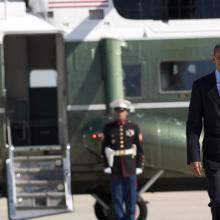Columbia
Fuller Theological Seminary has joined a growing list of schools where administrators are being pressed by students, alumni, and faculty for designation as a sanctuary campus.
In the aftermath of Donald Trump’s election as president, some campuses are considering the moniker “sanctuary campus,” which generally means that the university will not willingly give the government information about their students, staff, or faculty who are undocumented immigrants.
Activists from Colombia’s indigenous Nasa people continue to make headlines — but there’s far more to their peacemaking than the occasional story that makes the U.S. news. Here’s part II of the interview I did with two Nasa Indigenous Guard members, Manuel and Herman, in Cauca, Colombia, last August. The interview took place a month after an earlier round of violence: a bus bomb, suspected to be from the FARC, that went off in the town of Toribío, killing three and wounding more than a hundred in July 2012.
Sojourners: What’s it like to be in the Indigenous Guard?
German: Being an Indigenous Guard is very risky. Obviously there are moments of conflict in which you know what you’re facing -- then there are moments of apparent calm, but calm can switch into situations of risk very quickly.
The photos from rural Cauca, Colombia are so dramatic they’ve repeatedly made the international news: indigenous Colombian activists--bearing sticks, community spirit, and a whole lot of moxie--demanding that heavily-armed FARC guerrillas and government armed forces alike leave their territory. As the war between the FARC and the government heats up again in Cauca, civilians are — as usual — getting caught in the crossfire; the town of Toribío has been attacked 14 times this year, according to the BBC.
In response, Nasa activists last week shouted FARC guerrillas from their roadblocks back into the jungle, overran a hilltop government military outpost, and booed Colombian President Manuel Santos when he went to Toribío to hold a saber-rattling emergency cabinet meeting. (Yesterday, government forces used tear gas to drive out activists and re-occupy the post).
Last summer, in Cauca with Witness for Peace, I was able to interview two of those activists, members of the Indigenous Guard formed by the Nasa ethnic group. The Indigenous Guard , armed only with beribboned ceremonial staffs of office, has been standing up against armed groups for years--for example, marching into the jungle to successfully demand the release of Toribío’s mayor when the FARC abducted him in 2004. What empowers these activists? Here’s what I learned last year from two Indigenous Guard members, Manuel and German (as translated by Witness for Peace Associate Director Jess Hunter-Bowman)
Whatever President Obama does at the upcoming Summit of the Americas in Cartagena, Colombia this weekend may not be front-page news in the U.S—but for many Colombians trying to make an honest living in their homeland, it could just be Obama's "Mission Accomplished" banner moment.
President George W. Bush's May 2003 speech in front of a giant "Mission Accomplished" sign was, to put it mildly, a premature declaration of triumph in the U.S. war with Iraq, an enterprise that was a bad idea in the first place. In Cartagena this weekend, word is that Obama may declare that, after one year of a promised four-year plan, Colombia has met its commitments to crack down on offenses against Colombian workers' rights and lives.
It's ripped from the headlines: A young person is killed, but the police seem to be casting aspersions on the victim. It outrages us when it happens in Florida, and it should outrage us just as much when it happens further south.
It was not one person but five who were found murdered on March 15 in the town of San Isidro, Cauca, Colombia. They had been bound hand and foot and shot in the head. As in the case of Trayvon Martin, race was a factor: the victims were ethnically indigenous.
As I saw for myself when I visited Cauca last year, indigenous people in Colombia are (along with other historically marginalized groups) often stuck between a rock and a hard place —attacked or driven from their homes by both guerrilla insurgents and right-wing paramilitaries, both of which want to control territory and each of which accuses neutral parties of supporting the other side.




